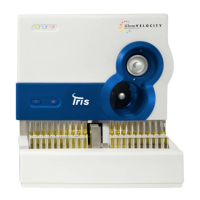7 Results
301-7146 English Rev B 11/02/2011 Operator’s Manual NA 112
Chapter 7 – Results
Results Interpretation
Microscopy and chemistry tests are complementary, not correlative. The
standard of care regarding urinalysis usually prescribes three
components: physical examination, chemical examination and
microscopic examination (Brunzel & Berry abstract, and AAFP 2005 MAR
15: 71(6), p1153). All three components are usually required because
there may be extenuating circumstances requiring a comprehensive
evaluation to make a diagnostic decision.
For example, a urine chemistry test may be positive for hemoglobin, but
the microscopic examination of the same specimen may be negative
because all the red blood cells have lysed in the specimen. A similar
situation can occur with leukocyte esterase and lysed white blood cells.
Conversely visualization of intact red blood cells by microscopy can
distinguish hematuria from other conditions, such as myoglobulinuria,
which would also give a positive chemistry reaction. A similar
phenomenon in white blood cells occurs when high specific gravity
causes crenation of leukocytes, preventing esterase release.
Therefore the analytical output from urine chemistry and urine microscopy
are not identical and should be used in a complementary manner to make
a final diagnosis.

